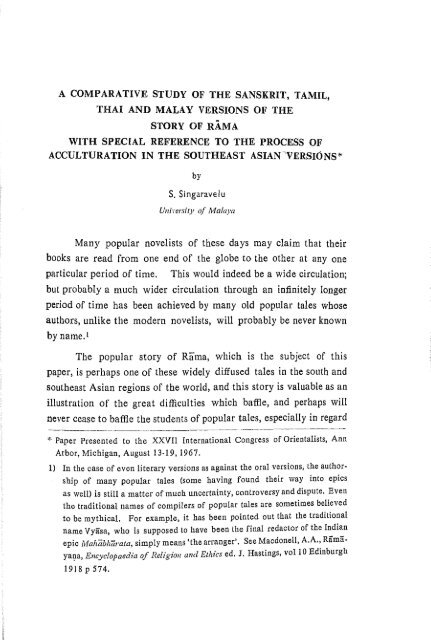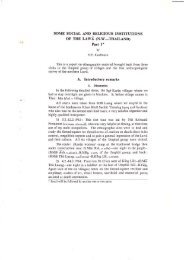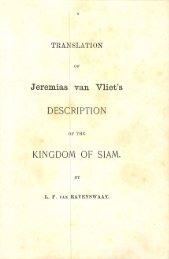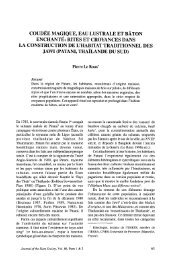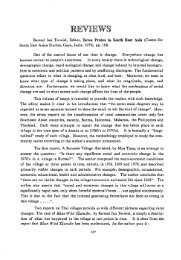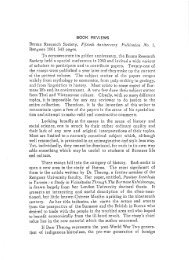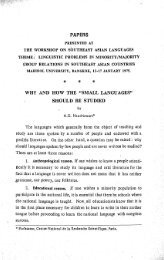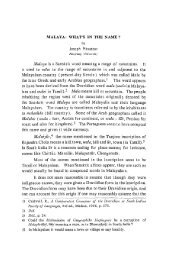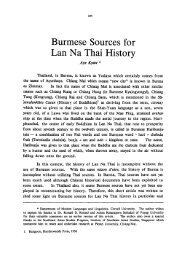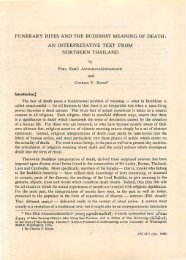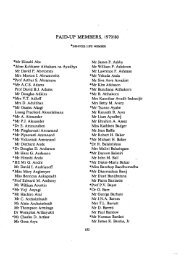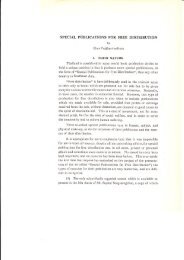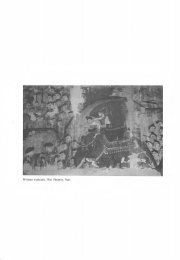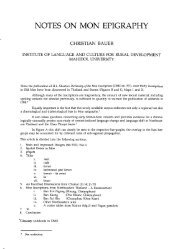A COMPARATIVE STUDY OF THE SANSKRIT, TAMIL, THAI AND ...
A COMPARATIVE STUDY OF THE SANSKRIT, TAMIL, THAI AND ...
A COMPARATIVE STUDY OF THE SANSKRIT, TAMIL, THAI AND ...
You also want an ePaper? Increase the reach of your titles
YUMPU automatically turns print PDFs into web optimized ePapers that Google loves.
SANSKHIT, TA\IIL, <strong>THAI</strong> <strong>AND</strong> MALAY VllHSIONS <strong>OF</strong> <strong>THE</strong> STORY <strong>OF</strong> RAMA 153<br />
might already have been current in oral or popular traditions before<br />
they had won their way into a literary version, though in modified<br />
forms.<br />
As for the second part of the problem, namely, the question of<br />
adaptation or diffusion and the related process of acculturation, it<br />
would be perhaps desirable to see first what a comparative study of<br />
the four versions, the Ramayat}a of Vi.ilmiki, the Ramavataram<br />
of Kamban, the Ramakian of King Rama I, and the Hikayat Seri Rama,<br />
has to offer by way of material evidence relating to the various episodes,<br />
incidents or motifs of the story. Before considering the data, a few<br />
words may be said about the scheme of presentation of the comparison<br />
and the textual sources utilized.<br />
To accommodate the mass of material in reasonably condensed<br />
form, the major episodes, incidents or motifs chosen for purposes of<br />
comparison are made into summarised lists which are marked by the<br />
letters of the Roman alphabet and arranged under brief descriptive<br />
beadings. It must be noted that no attempt is made in this paper to<br />
present all the episodes, incidents or motifs of each version concerned;<br />
such a huge task will have to wait until there is compiled a comprehensive<br />
and possibly comparative motif index of the various versions of<br />
the Rama story, perhaps through the collaboration of several interested<br />
workers in this field. For the purpose of facilitating quick comparison,<br />
the lists of such episodes or motifs as are presented in this paper and<br />
which would seem to vary from one version to another are arranged<br />
under the subheading, DIVERGENCES; whereas the lists of mottjs<br />
which agree between one version and the other are placed under the<br />
subheading, PARALLELS. The DIVERGENCES between the RamayatJa<br />
of Valmiki and the Ramiivataram of Kamban are summed up first.<br />
This is followed by the list of DIVERGENCES between the Ramaya1Ja<br />
of Valmiki and the Thai Ramakian on the one hand, and between the<br />
Tamil version of Kamban and the Thai Ramakian on the other. The<br />
final list of DIVERGENCES is ·of those between the Hikayat Seri Rama<br />
and the other versions concerned. This is followed by the lists of<br />
PARALLELS between the Tamil version and the Thai version and/or<br />
the Malay version on the one band, and between the Thai version and<br />
the Malay version on the other. The four versions concerned are to
<strong>SANSKRIT</strong>, <strong>TAMIL</strong>, <strong>THAI</strong> <strong>AND</strong> MALAY VERSIONS <strong>OF</strong> <strong>THE</strong> STORY <strong>OF</strong> RAM.\ 155<br />
Details of other books, papers and articles that have been<br />
valuable to this study can be found in the selected bibliographical<br />
notes provided as footnotes to this paper.<br />
Finally, a few words remain to be said on the bibliographical<br />
and textual citations given. The references to the numbers of the<br />
relevant Cantos, Books, Chapters, Verses, or Pages of the respective<br />
textual sources from which evidence is cited are given just below each<br />
corresponding major descriptive heading under which the lists of<br />
comparative data are arranged.<br />
The evidence from V.R. (the Ramayal}a of Valmiki) to be found<br />
in the English translation of that work by Hari Prasad Sastri is<br />
referred to by Volume, Book (Canto), Chapter and Page, in that<br />
sequence.<br />
As for the evidence from K.R. (the Ramavataram of Kamban)<br />
the references are to Volume (Canto), Chapter (pa,alam) and, wherever<br />
necessary, of the Verses to be found in Kambaramayanam, ed. V.M.<br />
Gopalakrishnama chari yar.<br />
The evidence from T.R. (the Ramakian of King Rama I of<br />
Thailand) to be found in the English summary translation of that<br />
work by Swami Satyananda Puri and Charoen Sarahiran is referred<br />
to by Chapters and Pages, in that order. Where necessary, references<br />
to the Thai text of the Ranzakian are also made by Volume, Book<br />
(section) and Pages of the edition concerned.<br />
With regard to the evidence from H.S.R. (the Hikayat Seri<br />
Ranza) the relevant page numbers of Shellabear's and Zieseniss' works<br />
are cited following the abbreviations Sh and Zies, respectively.<br />
l. BIRTH <strong>OF</strong> RAMA <strong>AND</strong> HIS BRO<strong>THE</strong>RS<br />
V.R.: HPS. 1. I. 9-18: 24-45; K.R.I. 5: T.R. II. 14-15;<br />
H.S.R.: Sh 51-62, Zies 13-18.<br />
DIVERGENCES<br />
I : V.R.I I K.R. (a) King DASARATHA tells his Prime Minister,<br />
SUMANTRA, of his desire to obtain an heir to the throne./ I
<strong>SANSKRIT</strong>, <strong>TAMIL</strong>, <strong>THAI</strong> <strong>AND</strong> lilA LAY VERSIONS <strong>OF</strong> <strong>THE</strong> STORY <strong>OF</strong> RAMA 15 9<br />
III. V.R./ /H.S.R. (a) Same as II (a)./ I SIT ADEWi is born<br />
as the daughter of MAHARAJA RAWANA.<br />
IV. K.R./ /T.R. and H.S.R. (a) Citai (Sitii) is revealed by the<br />
plough of King CANAKAN (Janaka)./ I SiDA in T.R. (SlTADEWi<br />
in H.S.R.) is first born as the daughter of THOTSAKAN in T.R.<br />
(MAHARA.JA RAWANA in H.S.R.).<br />
PARALLELS<br />
V: K.R.= T.R. (a) !RAMAN's (Phra RAM's in T.R.)eyes meet<br />
with the eyes of CiT AI (SiD A in T.R.) and they fall in love at first<br />
sight. (b) The bow of King CANAKAN (CHONOK CAKRAVARTI<br />
in T.R.) is said to have been used once by CIVAN (Siva; ISWAN in<br />
T.R.) to destroy TIRIPURAM (Tripura; TRIPURAM in T.R.).<br />
SUMMARY<br />
(a) In regard to the motifs encountered in this section, one<br />
striking motif, namely, that of Rama and Sita seeing each other for<br />
the first time is to be found in K.R. and T.R. but not in V.R. This<br />
motif is further discussed later in this paper in the context of diffusion<br />
and acculturation; see also Comparative Data, section 8. I (c).<br />
(b) With regard to the name-form, in K.R. TIRIPURAM<br />
(Skt. Tripura 'three cities') corresponds with TRIPURAM in T.R.,<br />
the latter form appearing, however, without the a nap tyxis or svarabhakti<br />
'i' between t and r as in the case of the Tamil name-form; the termination<br />
'am' is used to derive nouns of neuter singular form in Tamil.<br />
3. <strong>THE</strong> BANISHMENT <strong>OF</strong> RAMA<br />
V.R.: HPS. 1. II. 7-64: 164-303; K.R. II. 1-5; T.R. XIV. 37-38;<br />
H.S.R.: Zies 26-27.<br />
DIVERGENCES<br />
I: V.R./ /K.R. (a) There is no reference to RAMA'schildhood<br />
prank in maltreating MANTHARA, the hunch-backed maid of KAI<br />
KEYI./ / MANTARAI (Mantbara) or KUNI ('the hunch-backed one')
162 S. Singaravelu<br />
KHA (Ganga 'the Ganges'). (b) Same as I (b)./ I When PHOROT<br />
(Bharata) goes after Phra RAM be is accompanied by all the three<br />
widowed consorts of King THOSOROT (Dasaratha). (c) Same as<br />
I (c)./ I PHOROT (Bbarata) is barred from performing obsequies for<br />
King THOSOROT (Dagaratba). (d) Same as I (d)./ I PHOROT<br />
(Bharata) asks for and obtains Pbra RAM's own sandals for installa<br />
tion as symbols of his sovereignty.<br />
III: V.R./ I H.S.R. (a) The name-form of the boatman is<br />
GUHA.// The name-form in H.S.R. is KIKUKAN. (b) BARADAN<br />
(Bharata) receives SERiRAMA's sandals (PADUKA) and wears them<br />
on his head as a diadem.<br />
PARALLELS<br />
IV: K.R. = T.R. (a) IRAMAN and KUKAN (Phra RAM<br />
and KHUKHAN in T.R.) cross the river Ganges on the same barge<br />
(b) All the three widowed consorts of King Tacaratan (Thosorot in<br />
T.R.) accompany PARA TAN (PHOROT in T.R.) when he goes in<br />
search of his brother. (c) PARATAN (PHOROT in T.R.) is prevented<br />
from performing the obsequies due to his dead father on the<br />
instruction conveyed by V ACI'fT AN (SITTHA in T.R. ). (d) IRA MAN<br />
(Phra RAM in T.R.) bestows his sandals on the request of PARA TAN<br />
to serve as symbols of his sovereignty.<br />
V: K.R. and T.R. = H.S.R. (a) The name-form of the boatman<br />
is KUKAN in K.R., KHUKHAN in T.R., and KIKUKAN in H.S.R.<br />
(for GUHA in Skt.). (b) PARADAN (PHOROT in T.R. and BARA·<br />
DAN in H.S.R.) wears !RAMAN's sandals on his bead as a crown. ·<br />
SUMMARY<br />
(a) In regard to the motifs, the four variations of K.R. from<br />
V.R. are also the four parallels between K.R. and T.R.<br />
(b) Name-form : Kukan in K.R., Khukban in T.R. and Kikukan<br />
in H.S.R. are significantly similar, though derived from Skt. Guha.
166<br />
S. Singaravelu<br />
CATAYU, there is also another form, namely, JENTAYU, in which<br />
• a' becomes 'e' and there is also 'spontaneous nasalization' by the<br />
insertion of • n' bet ween • e' and • t '.<br />
8. RAMA'S MEETING WITH HANUMAN <strong>AND</strong> SUGRIV A,<br />
<strong>AND</strong> HANUMAN'S JOURNEY TO LANKA<br />
V.R.: HPS. 2. IV. 2-37: 171-267; K.R. IV. 2-12; T.R. XIX. 48-50;<br />
H.S.R.: Sh 88-102, Zies 51-56.<br />
V.R.: HPS. 2. V. 1-65: 327-498; K.R. IV. 12-17, V. 1-5;<br />
T.R. XXIII. 58-61;<br />
H.S.R.: Sh 106-117, Zies 58-64.<br />
DIVERGENCES<br />
I: V.R.//K.R., T.R. and H.S.R. (a) SUGRIVA himself<br />
relates to RAMA the story of his enmity with his elder brother<br />
VALl./ I In the other versions concerned, it is ANUMAN (HANU<br />
MAN in T.R. and MAHARAJA HANUMAN in H.S.R.) the com<br />
mander of CUKKIRIVAN (SUKHRIP in T.R. and MAHARAJA<br />
SUGRIWA in H.S.R.) who relates the story of his enmity with his<br />
brother VALl (PRALl in T.R. and BALYA or BALIRAJA in<br />
H.S.R.). (b) In K.R. and T.R., when IRAMAN (Phra RAM in<br />
T.R.) unjustly kills VALI (PHALi in T.R.) during the latter's battle<br />
with his brother, CUKKIRIVAN (SUKHRIP in T.R.), VALl, before<br />
be dies, rebukes IRAMAN for his unethical conduct. 3 9 (c) In K.R.<br />
and T.R. (but not in H.S.R.), just before ANUMAN (HANUMAN in<br />
T.R.) leaves for ILANKAI (LANKA in T.R.), !RAMAN (Pbra RAM<br />
in T.R.) reveals to him a secret known only to himself and CITAI<br />
(SIDA in T.R.) namely, that his eyes and her eyes met while he<br />
was on his way to the palace of the King of Mithila and they fell in<br />
love; 40 IRAMAN reveals this secret to ANUMAN so that the latter<br />
can make use of it as evidence of his trustworthiness as IRAMAN's<br />
emissary to ciTAI. (d) In K.R. and T.R. CITAI is said to hang<br />
39) Ibid., vol4 chap 7 pp 76-91.<br />
40) Ibid., vol 4 chap 13 p 67.
172<br />
S. Singaravelu<br />
relative of MAHARAJA RAW ANA, in the form of a crow robs one<br />
of the six rice balls and flies away to give it to MAHARAJA<br />
RAWANA who eats it; when MAHARAJA RAW ANA's wife MAN<br />
DODAR-I brings forth a beautiful daughter and it is feared that the<br />
child will cause the death of her own father, she is cast away in the<br />
waters to be rescued later by King MAHARiSi KALi. (b) In T.R.<br />
King CHONOK recovers sio.A after sixteen years with the help of a<br />
plough. In H.S.R. MAHARisi KALi finds the casket containing<br />
the child when he is engaged in morning worship. (c) When SATAYU<br />
(Jatayu) boasts that he can be killed only with SIDA's ring as a<br />
weapon, THOTSAKAN (Ravaqa) removes SIDA's ring and flings it<br />
at SATAYU. SITADEWi herself drops her ring into the beak of<br />
CATAYU to serve as a sign of her forceful abduction by MAHA<br />
RAJA RAW ANA. (d) In T.R. SUKHRiP (Sugriva) is said to make<br />
the pyre for SIDA's ordeal. In H.S.R. it ts HANUMAN who<br />
erects the fire. (e) In T.R. Pbra RAM is said to divide his vast<br />
kingdom among his allies, at the same time conferring titles denoting<br />
overlordships of the various principalities of the kingdom. In<br />
H.S.R. though there does not seem to be specific reference to the<br />
division of the newly enlarged kingdom, there are indications to<br />
suggest that in addition to bestowing rich treasures on his allies who<br />
refuse to return to their homes because of the affection they bear for<br />
him, SERi RAMA does acknowledge the assistance he has received<br />
from his allies by such gestures as bestowing a throne of equal height<br />
on JAMA MANTRi (the chief counsellor of MAHARAJA RAW ANA)•<br />
assigning posts to the courtiers in accordance with their lineage,<br />
making LAKSAMANA heir to the throne and HANUMAN his commander-in-chief.<br />
Thus, as seen in the near-similarities of the motifs,<br />
the Thai version and the Malay version would seem to have had<br />
notable connections with each other.<br />
Finally, in this section of comparative material relating to the<br />
four versions of the Rama story, the points of similarity in regard to<br />
certain name-forms may be summed up as follows: KALAIKKOTTU<br />
MUNI in the Tamil version and KALAIKOT in the Thai version;
<strong>SANSKRIT</strong>, <strong>TAMIL</strong>, <strong>THAI</strong> <strong>AND</strong> MALAY VERSIONS <strong>OF</strong> <strong>THE</strong> STORY <strong>OF</strong> RAMA 173<br />
TIRIPURAM in the Tamil version and TRIPURAM in the Thai<br />
version; MULABALAM in the Tamil version and MULABALAM in<br />
the Thai version; KUKAN in the Tamil version, KHUKHAN in the<br />
Thai version and KIKUKAN in the Malay version; CATAYU in the<br />
Tamil version, SA TAYU in the Thai version, and Catayu in the<br />
Malay version; PARADAN in the Tamil version and BARADAN in<br />
in the Malay version would seem to show connections of Tamil nameforms.<br />
Lets us now turn to the problem of adaptation or diffusion 42 and<br />
acculturation4 3 in the Southeast Asian literary versions of the story.<br />
The question before us is how far could we consider that the parallel<br />
motifs encountered in, say, the Tamil and the Thai versions, might<br />
have been the result of adaptation or diffusion from an earlier version<br />
and subsequent acculturation in a later version.<br />
In an attempt to throw some light on this rather complicated<br />
question, an episode is chosen from the Tamil and the Thai versions<br />
and the motifs as represented in the selected passages are compared<br />
in the following pages. The episode concerned is one to which a<br />
brief reference was made in section 2 of the comparative data above,<br />
namely, the one which describes how Rama and Sita happened to see<br />
each other for the first time and fell in love at first sight. First let<br />
us look at the Tamil passage, translated into English, followed by the<br />
translation of the passage containing the corresponding episode in<br />
the Thai version :<br />
42) A.L. Kroeber ('Diffusionism,' Encyclopedia of the Social Sciences vol5, 19 31<br />
pp 139-42) defines 'diffusion' as a 'process by which elements or systems of'<br />
culture are spread, by which an invention or a new institution adopted in one<br />
place is adopted in neighbouring areas ... in some cases ... until it may<br />
spread over the whole world.'<br />
43) According to the definition published by the Sub-Committee of the Social<br />
Science Research Council in: Redfield, R., Linton, R. and Herskovits, M.J.,<br />
'A memorandum for the study of acculturation' American Anthropologist vol<br />
38, 1935 pp 149-52, an outline of which is reproduced as an appendix<br />
to Herskovits, M.J., Acculturation Gloucester, Mass. 1958 PP 131-36,<br />
acculturati6m comprehends those phenomena which result when groups of<br />
individuals having different cultures come into continuous first-hand contact,<br />
with subsequent changes in the original cultural patterns of either or both<br />
groups.
176<br />
v. 23.<br />
S. Singaravelu<br />
They saw the courtyard where the swans walked majestically,<br />
by the side of the upper-storey of the mansions where Sita of<br />
golden splendour, flowery fragrance, honey-like sweetness and<br />
song-like happiness was to be seen.<br />
V. 24.<br />
Now that the peerless goddess of wealth (Sri) herself is here as<br />
Sita there is none to choose and to compare with SitU.<br />
V. 35.<br />
The young maiden of unimaginable charm, standing by the<br />
window of the lofty mansion, and the lord standing below, he<br />
looked and she also looked; their eyes ate into each other; their<br />
hearts were united.<br />
v. 36.<br />
Her spear-like eyes penetrating the sturdy shoulders of Rama,<br />
Rama's red lotus-like eyes too made a deep impression on the<br />
goddess-like Sini.<br />
V. 37.<br />
They were bound to each other by their looks, their hearts<br />
drawing each other together, they entered each other's heart.<br />
v. 38.<br />
Sita with an invisible waist and faultless Rama became one<br />
soul, though of two bodies. There is no need to say much<br />
about their love after their reunion now since their parting at<br />
their abode on the dark sea with the great serpent as their bed.<br />
v. 39.<br />
Sitii was standing like a painted picture for she looked at Rama<br />
without winking her eyes even once. Rama soon moved on with<br />
the sage, with his mind full of thoughts of the beautiful Sita.
<strong>SANSKRIT</strong>, <strong>TAMIL</strong>, '!'HAl <strong>AND</strong> MALAY VERSIONS <strong>OF</strong> <strong>THE</strong> STORY <strong>OF</strong> RAMA 177<br />
v. 40.<br />
As Raroa vanished out of sight, Sita felt helpless and unable to<br />
control her passion for Rama, like any other maiden who is in<br />
love; her mind now sought after Raroa.<br />
v. 42.<br />
Sita suffered from love-sickness. Not being able to confide in<br />
anybody else, she sobbed within her own heart.<br />
v. 51.<br />
Her maids-in-waiting asked what caused this illness, but they<br />
were not able to know.<br />
v. 53.<br />
Sita began to moan and lament, remembering the image<br />
of Rama, his appearance, his hair, his pillar-like arms, his red<br />
lotus-like eyes; his resemblance to the cloud with the bow of<br />
Indra (rain-bow).<br />
v. 60.<br />
During this sickness of love, Sita would utter words that made<br />
no sense. Sbe would prattle to herself, 'here he is; alas, he is<br />
gone now.'<br />
V. 61.<br />
The sun, the source of ancient heat, withdrew his long arms of<br />
rays towards himself and being unable to bear the heat of Sita's<br />
passion sank beneath the ocean.<br />
V. 62.<br />
As the evening descended it brought no relief to Sita. Her<br />
love-sickness grew worse; the fire of the passion now raged<br />
with great intensity.<br />
RAMAKIAN: Book 14 (in Vol.l) pp. 381-382.<br />
'Phra Ram (together with Phra Lak and the sage) crossed,<br />
over the stream and proceeded winding along the meadow in<br />
their journey through the great forest and arrived at the mighty<br />
city of Mithila, and directly entered the city's gates.
178<br />
S. Singaravelu<br />
Thus Phra Ram looked intently at the city of Mithila<br />
which was gay like the joyful heavenly land. There were<br />
edifices, mansions and shops situated neatly along the avenues.<br />
There were gay and noisy crowds of citizens, both men and<br />
women.<br />
There were also stables for elephants and horses. There<br />
were arenas too in which the mighty elephants tested their<br />
strength.<br />
There were rows of flags (hoisted upon) the poles and/or<br />
of the tiered royal umbrellas; the flags were waving and shining<br />
forth as though they were beckoning the royal visitor (with the<br />
words), 'we beseech Your Majesty to be gracious enough to<br />
make haste and proceed; Your Majesty will have the gracious<br />
maiden, Sida (Sita).'<br />
Bewildered and being in a doubtful frame of mind as to<br />
what was in store for him, the royal visitor walked on, at the<br />
same time casting his glance to look at the royal palace which<br />
was like the mansion of Indra. Its five towers of crystal<br />
combined with gold shone with the gabled roofs and golden<br />
images on four directions, supported by the figures of naga motif<br />
standing upright.<br />
Phra Ram admired the golden crystal gem at the royal<br />
window, unforgettably beautiful like the goddess. Phra Ram's<br />
eyes met with those of Sida; glamorous charms combined to<br />
bind their hearts tightly together.<br />
Thus, the youthful Sida, on the upper-storey oft be mansion,<br />
rejoicing and glancing furtively through the aperture of the<br />
latticed window while being hidden, triumphantly met her royal<br />
eyes with those of the four-armed Phra Ram. Love, till then<br />
restrained, gushed forth, as Sida was indeed accustomed to be<br />
seated at the feet of her lord in her previous existence.<br />
Boundless love and longings sprang forth in the heart of<br />
the young and beautiful maiden just now.<br />
Thus, Phra Ram conferred his blessing of boundless love<br />
on the auspicious maiden, like fire touching her heart. Phra
182 S. Singaravelu<br />
different combinations both passage·s have also some different motifs<br />
of their own. Among the motifs that appear to be similar is at least<br />
one which is more striking then the others, namely, the motif referring<br />
to the flags fluttering from poles (and the tiered umbrellas) as<br />
though they were welcoming the royal and divine visitor to the city<br />
of Mithila to receive Sita. Though this mottj is so strikingly similar,<br />
it would nevertheless seem to have received an added refinement at<br />
the hand of the royal poet King Rama I, to the effect that the image<br />
conveyed is one of flags fluttering from the tiered royal umbrellas in<br />
addition to the ordinary flag-masts. The additional refinement is<br />
understandable in view of the fact that, though the white umbrella<br />
has been a common emblem of royalty in South and South-east Asia<br />
since early times, the tiered royal umbrella is particularly a noteworthy<br />
feature of the Thai royal regalia. (The multi-tiered royal umbrella<br />
is believed to have been a development from the traditional practice<br />
of kings symbolically adding their own umbrellas on top of those of<br />
former rulers). 45<br />
Again, to cite another motif in the Thai version, the description<br />
of the royal mansion as having gabled roofs decorated with the naga or<br />
makara mottj is obviously in consonance with a style of architecture<br />
which has been typical of the Thai tradition.<br />
From these two instances it would seem that in literary<br />
acculturation as indeed in artistic or even linguistic acculturation, the<br />
final treatment often rests with the people who choose to adopt<br />
elements from other sources.<br />
Now, as for the motif of a man and a woman falling in love<br />
at first sight. This is probably one of the oldest mottjs in the cultural<br />
traditions of the world's peoples, and especially so in the Tamil<br />
literary tradition and probably in the Thai literary tradition as well.<br />
It is also of some interest to note that this motif would in fact seem<br />
to be in contradistinction to an opposite motif, which we may come<br />
across elsewhere, namely, the prohibition against seeing the prospective<br />
bride or the bridegroom, which is known to be enforced even by<br />
supernatural sanction of punishment for infringing such a taboo. In<br />
45) See Quaritch Wales, H. G., Siamese State Ceremonies London 1931 pp 93-95.
SANSKHIT, T:U!IL, <strong>THAI</strong> A :liD MALAY \'ERSIONS <strong>OF</strong> <strong>THE</strong> STORY <strong>OF</strong> RAMA 18 3<br />
view of the fact that such a taboo is known to have existed in the<br />
northern parts of India, 46 can we surmise that the possible existence<br />
of such a taboo probably prevented the inclusion of its opposite motif<br />
(namely, that of the prospective bride and groom seeing each other<br />
before marriage) in the Ramayal).a of Valmiki who seems to have<br />
confined himself merely to the narration of how Rama won the hand<br />
of Sita at an archery contest which was a special form of the svayamvara<br />
('self-choice') type of gcmdharva marriage, though concluded<br />
subsequently by the performance of the rites of religious marriage? Be<br />
that as it may, it is nevertheless a noteworthy feature that both the<br />
Tamil and Thai versions have seen fit to include such a popular motif<br />
in keeping with their ancient traditions.<br />
The problem of adaptation or diffusion and acculturation is<br />
indeed beset with many complexities, and it is not at all easy to<br />
pin-point the diffused elements and the manner of their acculturation.<br />
It has been argued by folklorists that, given a similar state of<br />
taste, fancy, similar beliefs, similar circumstances, a 'similar' tale<br />
might conceivably be evolved in regions remote from each other.<br />
Just as similar patterns of art have been independently evolved, so<br />
similar cosmic myths, similar fables, riddles, proverbs, customs, and<br />
institutions may have been independently evolved.<br />
However, where the similar incidents, similar motifs, and<br />
similar details are more numerous (as we have seen is tbe case in the<br />
foregoing pages of this paper), independent invention may be difficult<br />
to argue but some form of diffusion may be considered possible.<br />
When the chain and sequence of events or motifs keeps close to a<br />
given type, one may regard such elements of the story as probably<br />
borrowed or transmitted. In the chain of such sequence of motifs<br />
one may see borrowing or transmission of the elements concerned so<br />
far as one cannot reason from possible coincidence.<br />
But, whatever be the agreement (or variation) in regard to<br />
given motifs or sequence of events in the various versions of the story<br />
concerned, we cannot be indifferent to the individual literary merits<br />
of the works concerned and to the constructive art which is bound to<br />
46) See Basham, A.L., The Wonder That Was India London 1961 PP 165-70.
184<br />
S. Singaravelu<br />
be displayed in the composition of these works. In other words,<br />
though there may be numerous similar elements diffused among several<br />
versions, one cannot argue that the works possessing the same<br />
or similar motifs are the same, for the combination of motifs and<br />
incidents may indeed take almost any form. Even if the same plot and<br />
motifs are used in two given literary works we may still be able to<br />
observe and appreciate the original qualities of combination of those<br />
elements in different guises. Various motifs may appear in various<br />
combinations and these may undergo kaleidoscopic change. The<br />
incidents or motifs would be the bits of coloured gems; shaken, they<br />
would fall into a variety of attractive forms.<br />
There is also another feature of diffusion and acculturation<br />
which is worthy of note. Though incidents or motzfs of the<br />
common store may be interwoven in any form, at the same time<br />
certain forms or combinations may in the course of time gain<br />
currency as the fittest, and these may be retained and more widely<br />
spread than the others. In other words, some form of the motifs<br />
may be judged by the skilled narrators or composers as the fittest,<br />
and they would survive. The story-tellers are known to have always<br />
been making varied combinations, the best and the most dramatic of<br />
which often survive: a good type of motif, once bit upon, is diffused<br />
widely, though we cannot be so fortunate as to be aware of the name<br />
and home of the combiner or the date of the combination.<br />
Again, with all the many variations to be found in several<br />
versions of a popular tale, it is remarkable that the tale should retain a<br />
definite enough quality to be considered a real entity. This is perhaps<br />
because the characteristic incidents or motifs of the story, though<br />
varied, are still so constant that it is not difficult to recognise their<br />
type in spite of the almost kaleidoscopic variations they have<br />
assumed. It is also of interest to note that the variations deal with<br />
materials handled in different fashion; sometimes appearing as part<br />
of local environment, legend, and traditions, and at other times<br />
receiving local literary treatment.<br />
As Stith Thompson has observed so aptly, the telling of tales<br />
is not uniform in various parts of the world. Like other elements of<br />
culture, tales are not mere creatures of chance; they exist in time and<br />
space, and are affected by the nature of the land where they have been


